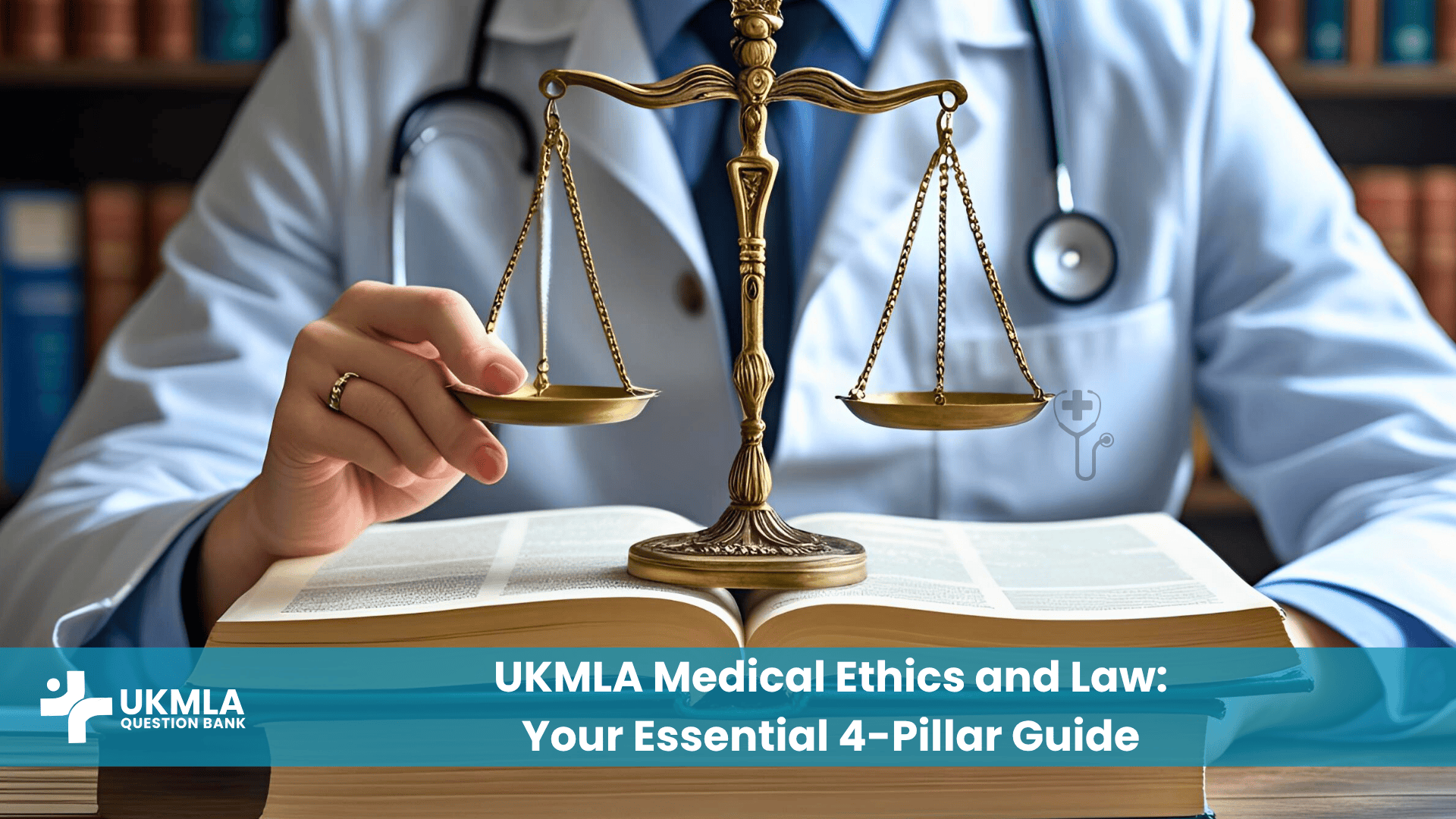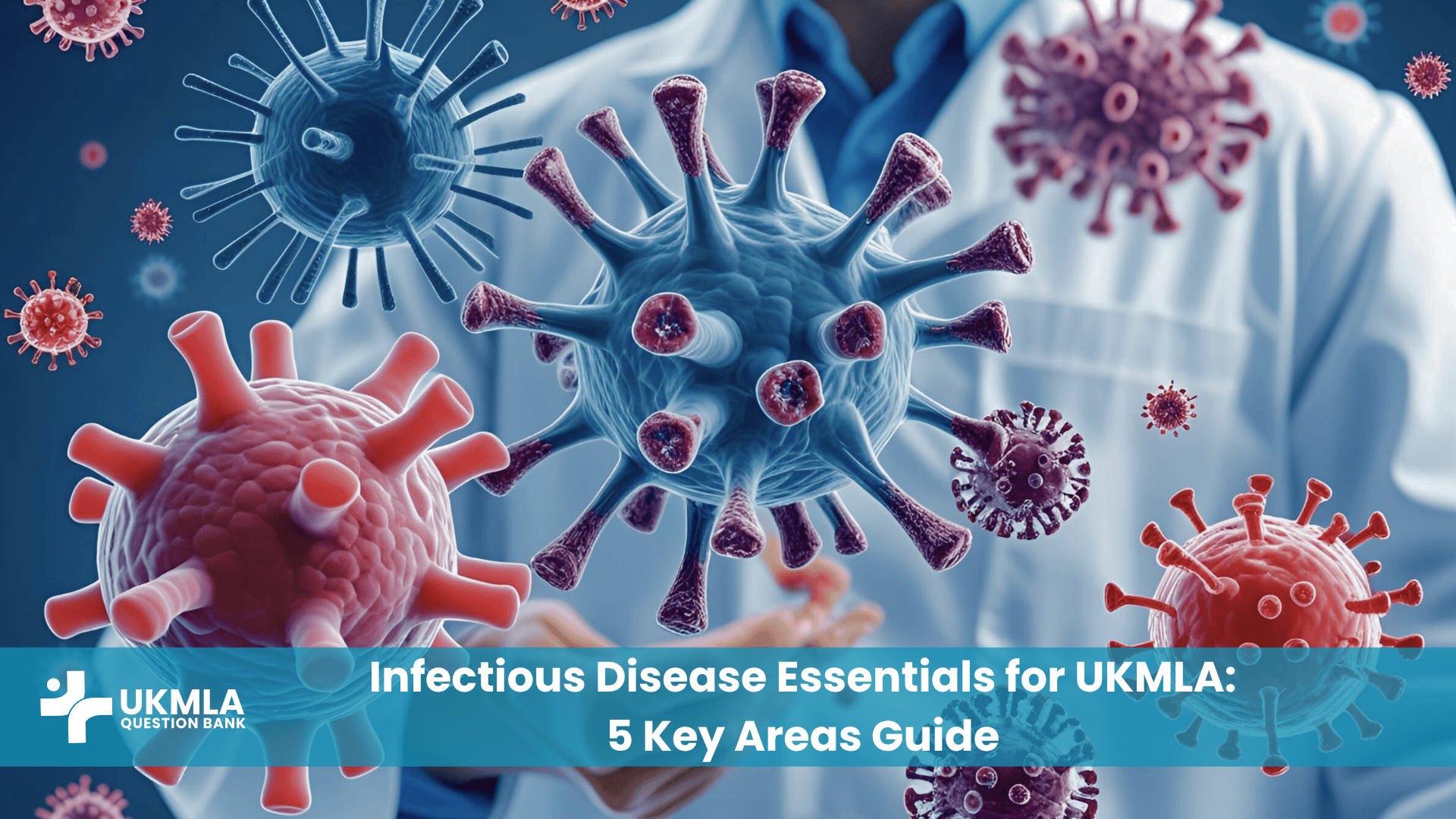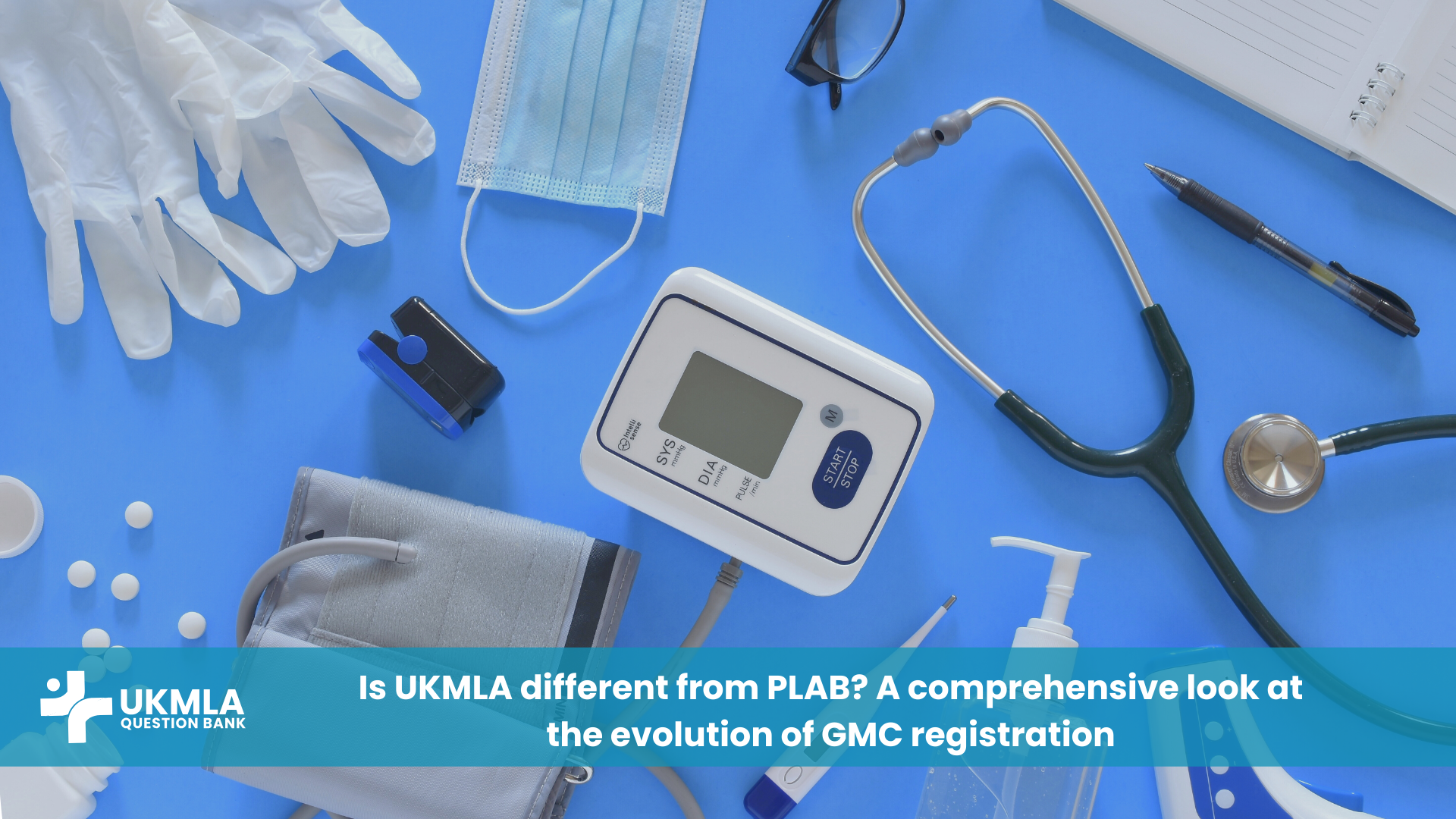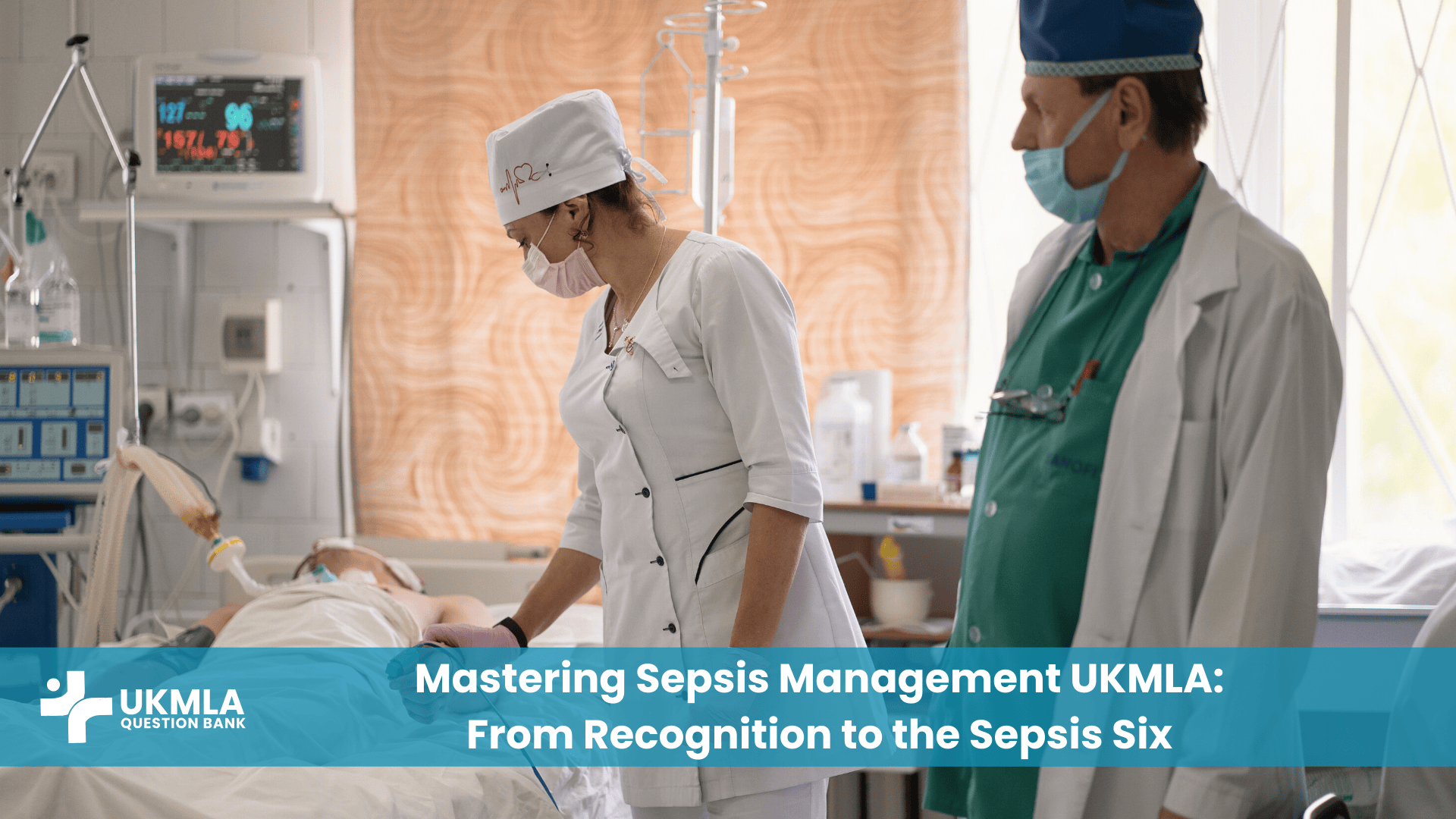Introduction
Understanding the principles of medical ethics and law for UKMLA is a non-negotiable cornerstone of your exam preparation and your future career. The UK Medical Licensing Assessment (UKMLA) is designed to ensure new doctors are not just clinically knowledgeable, but are also prepared to be safe, trustworthy, and professional practitioners. Questions on ethics and law are not “soft” topics with subjective answers; they are a critical test of your ability to apply established principles and legal frameworks to complex, real-world scenarios.
This guide is designed to demystify this challenging area. We will move away from abstract theory and provide you with a simple, robust framework built on four essential pillars. By mastering these pillars, you will develop the confidence to deconstruct any ethical or legal vignette in the AKT (Applied Knowledge Test), identify the core conflict, and select the most appropriate, defensible course of action.
Key Takeaways
Structure Revision Around the 4 Pillars: Focus your study on the four key areas: Consent & Capacity, Confidentiality, Negligence & Duty of Care, and Core Ethical Principles & Professionalism, as this covers the majority of testable material.
GMC Guidance is the Gold Standard: In any ethical dilemma presented in the UKMLA, the “correct” answer is the one that aligns with the principles in the GMC’s “Good Medical Practice,” not personal opinion. This is the framework you are being tested on.
Master Consent in Nuanced Situations: Go beyond basic consent. Understand the specifics of assessing capacity using the Mental Capacity Act, and know the key differences between Gillick competence and Fraser guidelines for treating minors.
Know When Confidentiality Can Be Breached: While patient confidentiality is a core duty, you must know the specific justifications for breaching it: with the patient’s consent, when required by law, or when it is in the public interest to prevent serious harm.
Apply a Framework to Ethical Scenarios: When faced with an ethical SBA (Single Best Answer), first identify the core conflict (e.g., Autonomy vs. Beneficence), then apply the relevant legal and ethical principles to choose the most appropriate action.
The 4 Pillars of Medical Ethics and Law for UKMLA
To succeed in this domain, you must structure your thinking. These four pillars provide a framework that covers the vast majority of ethical and legal questions you will face in the UKMLA AKT.
1: Consent & Capacity
This is the bedrock of every patient interaction and a high-yield area for exams. For consent to be legally valid, it must meet three criteria: the patient must give it voluntarily, be appropriately informed, and have the capacity to make the decision.
Assessing Capacity: The Mental Capacity Act (MCA) 2005 is the key piece of legislation here. A patient is presumed to have capacity unless proven otherwise. To lack capacity, a person must have an impairment of the mind or brain and be unable to do one or more of the following:
Understand the information relevant to the decision.
Retain that information.
Use or weigh that information as part of the decision-making process.
Communicate their decision.
Children and Consent: This is a particularly nuanced and frequently tested area.
Clinical Pearl: “A child who is Gillick competent can consent to their own treatment, but a parent cannot override that consent. However, if a Gillick competent child refuses life-saving treatment, a court can overrule their decision. This highlights the primary importance of a child’s best interests.”
Table 1: Key Legal Concepts for Consent in Minors
| Concept | Description | Key Points |
|---|---|---|
| Gillick Competence | A legal principle stating that a child under 16 can consent to their own medical treatment if they demonstrate sufficient intelligence, maturity, and understanding of the proposed treatment. | Applies to all medical treatment. It is an assessment of an individual child’s capacity. |
| Fraser Guidelines | Specific legal guidance related to providing contraceptive advice and treatment to a person under 16 without parental consent. | A doctor can proceed if the young person understands the advice, cannot be persuaded to inform their parents, is likely to continue having intercourse with or without contraception, and their physical or mental health is likely to suffer without the advice/treatment. |
| Parental Responsibility | Those with parental responsibility can consent on behalf of a non-Gillick competent child. | For major decisions, consent from one person with parental responsibility is usually sufficient. |
2: Confidentiality & Data Protection
A doctor’s duty to protect patient information is a fundamental principle of medical practice. It is not just an ethical duty but also a legal one under the Data Protection Act and common law.
The core principle is that information shared by a patient should not be disclosed without their consent. However, the UKMLA will test your knowledge of the exceptions. You may breach confidentiality when:
The patient consents: This is the most straightforward justification.
It is required by law: For example, notifying public health bodies of certain infectious diseases or reporting a gunshot wound to the police.
It is in the public interest: This is the most complex area. A public interest disclosure may be justified if failing to do so would expose others to a risk of death or serious harm (e.g., informing the DVLA that a bus driver has uncontrolled epilepsy and continues to drive).
This is a balancing act, and you must always be able to justify your decision. The GMC’s detailed guidance on “Confidentiality” is the definitive document on this and essential reading.
3: Negligence & Duty of Care
This pillar covers the legal framework for when things go wrong. Clinical negligence is a form of tort law, and questions will test your understanding of the principles, not your ability to act as a lawyer.
For a claim of negligence to be successful, a claimant must prove four things on the balance of probabilities:
Duty: The doctor owed the patient a “duty of care” (this is almost always present in a doctor-patient relationship).
Breach: The doctor’s practice fell below the standard of a reasonably competent professional in that field. This is judged by the Bolam test (acting in accordance with a practice accepted as proper by a responsible body of medical men skilled in that particular art).
Causation: The breach of duty directly caused the harm. The “but for” test is applied: “but for” the doctor’s action, would the harm have occurred?
Harm: The patient suffered actual harm, loss, or damage as a result.
Legal Principle Spotlight: The Bolitho Test “The Bolam test isn’t absolute. The Bolitho amendment added a crucial detail: the practice accepted by a responsible body of doctors must also be logical and defensible. A court can find a doctor negligent if the expert opinion supporting their action is not based on logical reasoning.”
Understanding this framework is key to deconstructing scenarios about clinical error. For more insight into avoiding pitfalls, see our guide on common UKMLA mistakes to avoid.
4: Core Ethical Principles & Professionalism
This pillar underpins all others and is based on the principles outlined in the GMC’s “Good Medical Practice.” This is the foundational document for all professional standards in the UK.
The Four Pillars of Medical Ethics: This classic framework helps resolve ethical dilemmas.
Beneficence: Acting in the patient’s best interests.
Non-maleficence: First, do no harm.
Autonomy: Respecting the patient’s right to make their own decisions.
Justice: Ensuring fairness in treatment and the distribution of resources.
Professionalism in Practice: UKMLA scenarios will test your professional behaviour. This includes topics like:
Duty of Candour: The professional responsibility to be open and honest with patients when something goes wrong that has caused or could cause harm.
End-of-Life Care: Principles surrounding DNACPR decisions (they are about avoiding futile CPR, not “giving up”) and the legal status of advance decisions to refuse treatment.
Maintaining Boundaries: Recognising and managing professional boundaries with patients and colleagues.
This pillar is directly linked to the UKMLA’s focus on professionalism and patient safety, making it a high-yield area for your revision.
Applying Ethical Principles to UKMLA SBAs
These questions require a specific technique. You must apply established principles, not your own personal moral code.
Step 1: Deconstruct the Ethical Vignette: Identify all the parties involved (patient, family, colleagues) and the core facts of the scenario.
Step 2: Identify the Core Conflict: What is the central dilemma? Is it a conflict between Autonomy (patient refusing treatment) and Beneficence (doctor wanting to treat)? Is it a clash between Confidentiality and the Public Interest?
Step 3: Choose the “Most Appropriate” Action: The options in an SBA (Single Best Answer) will often include several plausible actions. You must choose the one that best aligns with GMC guidance and legal principles. Often, the best initial step is to “talk to the patient further” or “discuss with a senior colleague.” Our guide on tackling SBAs effectively can help you refine this skill.
Frequently Asked Questions (FAQ): Medical Ethics and Law
Law dictates the minimum standard of conduct that society requires, and breaking it can lead to legal penalties. Ethics is the moral framework that guides professional conduct, often setting a higher standard than the law. What is legal is not always ethical, and what is ethical is not always a legal requirement.
You will likely be given a scenario (e.g., a patient with a new diagnosis of epilepsy) and asked about your responsibility. You are expected to know the patient’s legal duty to inform the DVLA and your own duty to advise them of this, and in rare cases, to breach confidentiality and inform the DVLA yourself if the patient will not and poses a risk to the public.
You should know the basic principles of the Abortion Act 1967: that it requires the agreement of two doctors and is performed based on specific grounds (e.g., risk to the physical or mental health of the mother).
Euthanasia and assisted suicide are illegal in the UK. A doctor cannot actively end a patient’s life. This is distinct from withdrawing futile treatment or providing palliative care that may inadvertently shorten life (the doctrine of double effect), which are legal and ethical.
You are not expected to be a lawyer. You need to understand the principles of key legislation like the Mental Capacity Act 2005, the Mental Health Act, and the Abortion Act 1967, and how they apply to clinical practice.
Read the GMC’s “Good Medical Practice” and their core ethical guidance (especially on Consent and Confidentiality). Then, work through as many ethical and legal SBAs as possible from a high-quality UKMLA question bank to see how these principles are tested in practice.
The principles of patient safety are paramount. Your first steps are usually to gather information and then raise your concerns, typically with a senior colleague, a clinical tutor, or your educational supervisor. The answer is rarely to confront the colleague directly or to ignore the problem.
This ethical principle states that an action with both a good intention (e.g., relieving pain with morphine) and a foreseeable but unintended bad outcome (e.g., respiratory depression that shortens life) can be ethically permissible. The intention must be solely for the good outcome.
In the context of the UKMLA, yes. While real-life ethics can be grey, exam questions are designed to have a “most appropriate” answer based on established GMC guidance and legal precedent. You are being tested on your knowledge of this established framework.
Ethics, law, and professionalism are not an isolated topic; they are woven into the “Professionalism” domain of the GMC’s UKMLA Content Map and are relevant to every single clinical presentation.
Conclusion & Call to Action (CTA)
Mastering the principles of medical ethics and law for UKMLA is about learning to think like a professional. It requires you to move beyond personal opinion and apply a consistent, defensible framework to every clinical encounter. By building your understanding on the four pillars of Consent & Capacity, Confidentiality, Negligence, and Core Professionalism, you will be prepared for any ethical or legal challenge the AKT presents.
Remember that every scenario is an opportunity to demonstrate that you are a safe, trustworthy, and principled doctor in the making. This is not just about passing an exam; it’s about earning the trust that patients will place in you for the rest of your career.
Ready to apply these principles to complex ethical and legal scenarios? Test your reasoning with the comprehensive UKMLA Question Bank and master this essential component of the UKMLA.




